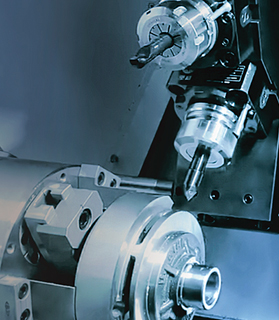"Center lathes" usually refer to the more basic traditional horizontal lathes. The core working method is to use the top of the spindle box and the tailsto...
READ MORE
-
-
What is a center lathe? The term "center lathe" usually refers to the more common and basic traditional horizontal lathe, which is what we often call an or...
READ MORE -
Eastern CNC Profile Taizhou Eastern Numerical Control Equipment Co., Ltd. (hereinafter referred to as Eastern CNC) is a well-known domestic CNC machine too...
READ MORE -
With the continuous demand for high-precision and high-efficiency processing equipment in the manufacturing industry, slant bed CNC lathes are gradually be...
READ MORE -
Introduction to Horizontal CNC Lathes The horizontal CNC lathe is a versatile machine tool that is used for shaping and cutting metal or other materials. T...
READ MORE
Vertical turn mill center is a versatile machine tool that combines the capabilities of a vertical lathe and a milling machine. This design allows for both turning and milling operations on a single setup, improving efficiency and precision. The vertical orientation is ideal for handling large, heavy workpieces, utilizing gravity for enhanced stability. Equipped with live tooling, these centers can perform complex machining tasks such as drilling, tapping, and contouring. Commonly used in industries like automotive, and energy, vertical turn-mill centers are essential for producing intricate, high-quality components with reduced cycle times and increased accuracy.
The Role of CNC Lathes and Turning Machines
CNC lathes and turning machines operate by rotating a workpiece while a stationary cutting tool removes material to achieve the desired shape. Controlled by computer numerical control (CNC) systems, they ensure high accuracy and repeatability, making them ideal for producing parts with tight tolerances.
The primary functions of CNC lathes include turning, facing, threading, and boring. These operations allow for the creation of a wide range of components, from simple shafts and bushings to complex geometries found in automotive and parts. CNC lathes can handle various materials, including metals, plastics, and composites, further broadening their application scope.
One of the significant advantages of CNC lathes and turning machines is their automation capability. By following pre-programmed instructions, they small manual intervention, reducing the risk of human error and increasing production efficiency. This automation also allows for continuous operation, which is beneficial for high-volume production runs.
Modern CNC lathes often feature additional functionalities, such as live tooling, sub-spindles, and Y-axis capabilities. Live tooling enables milling, drilling, and tapping operations, enhancing the machine's versatility. Sub spindles allow for machining on both ends of a workpiece without repositioning, saving time and improving accuracy. Y-axis capabilities provide greater flexibility in tool movement, enabling more complex machining tasks.
Operators of CNC lathes need to be skilled in programming and machine setup to optimize performance and ensure safety. Proper maintenance is also crucial to keep the machines in ideal working condition and prolong their lifespan.
Stability and Precision with CNC Vertical Turning Centers
CNC vertical turning centers are advanced machine tools designed for machining large and heavy workpieces with high precision and efficiency. Unlike horizontal lathes, vertical turning centers position the spindle vertically, allowing gravity to assist in stabilizing the workpiece during machining. This orientation is particularly advantageous for handling large diameters and heavy components, such as those found in the automotive, and energy industries.
The primary advantage of CNC vertical turning centers lies in their ability to machine large, heavy parts with exceptional stability. The vertical spindle orientation ensures that the workpiece remains securely in place, reducing the risk of deflection and vibration. This stability translates to improved machining accuracy and surface finish, which are critical in producing high-quality components.
These machines are capable of performing a variety of operations, including turning, facing, boring, and threading. Additionally, many CNC vertical turning centers come equipped with live tooling, allowing for milling, drilling, and tapping operations within the same setup. This multifunctional capability reduces the need for multiple machines and setups, enhancing production efficiency and reducing cycle times.
CNC vertical turning centers often feature robust construction and powerful motors to handle the demands of machining large and heavy parts. They are designed to withstand significant forces and stresses, ensuring consistent performance and reliability. Advanced control systems and software enable precise programming and operation, further enhancing their capabilities.
Operators of CNC vertical turning centers must be proficient in programming and setup to fully utilize the machine's potential. Proper maintenance is also essential to ensure longevity and ideal performance.
-
01
Contact Us
All of your quotes will be answered within 2 hours by our professional sales support.
-
02
Get A Free Quote
Use reliable parts and components to ensure product quality.
-
03
Fast Delivery
You can expect your order fulfilled within 60 days after placing the order.
-
04
After-sale Support
You can enjoy a one-year many for all of our produons.
















